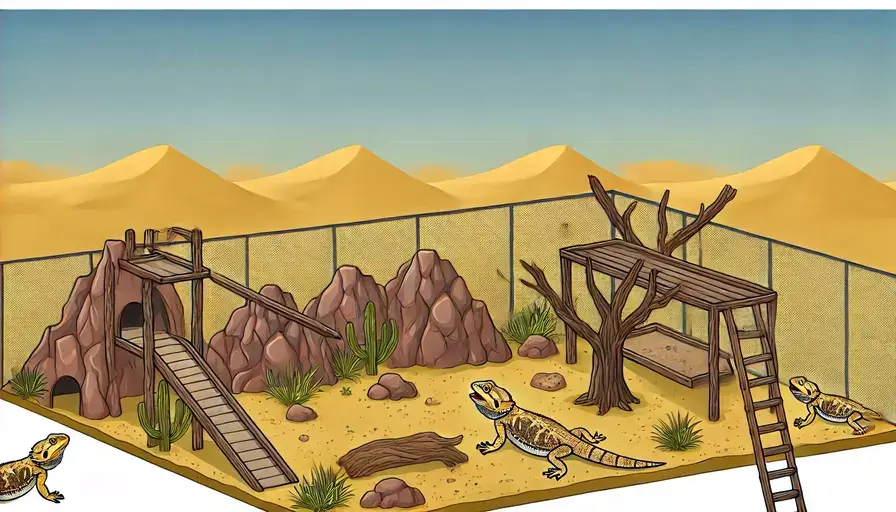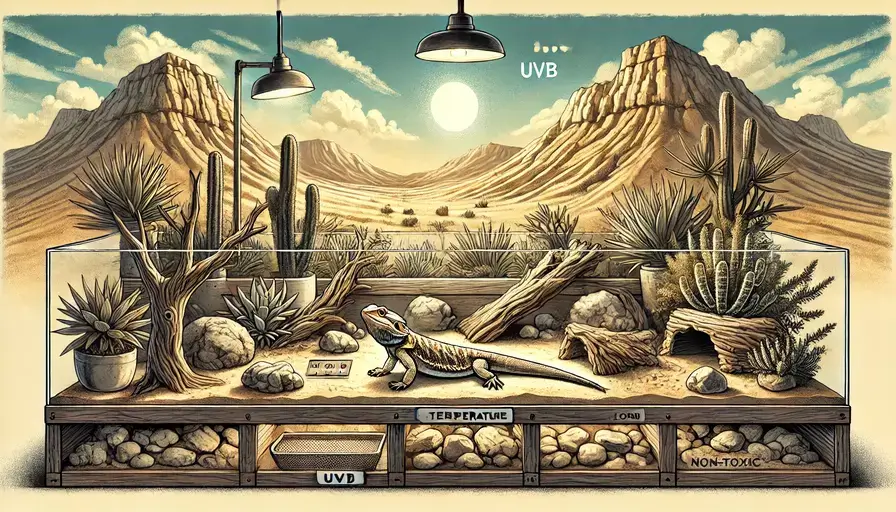Everything you need to know about bearded dragon habitat! Bearded dragons are one of the most popular reptiles to keep as pets due to their docile nature and unique personalities.
Creating the ideal habitat for a bearded dragon is crucial for ensuring their health and happiness. This guide will cover the essentials of what kind of habitat a bearded dragon needs, where they usually live in the wild, and how to build a habitat that mimics their natural environment.
What Kind of Habitat Does a Bearded Dragon Need?
A bearded dragon requires a habitat that closely replicates their natural environment, which is arid, rocky, and sparsely vegetated. The key components of a suitable bearded dragon habitat include:
- Size: An adult bearded dragon needs a tank that is at least 40 gallons, but larger is preferable to provide ample space for movement.
- Temperature: The habitat should have a temperature gradient, with a basking area between 95-110°F and a cooler area around 80-85°F.
- Lighting: UVB lighting is essential for calcium metabolism, and it should cover at least two-thirds of the tank to simulate the sunlight they would receive in the wild.
- Substrate: The floor of the habitat should be covered with a safe substrate such as reptile carpet or ceramic tiles. Avoid sand or loose substrates that can cause impaction if ingested.
Where Do Bearded Dragons Usually Live?
In the wild, bearded dragons are native to the arid, rocky deserts of Australia. They thrive in hot, dry environments with plenty of sun exposure. This natural setting is crucial to understand as it influences the design of their captive habitat, ensuring that it supports their physiological and behavioral needs.

How to Build a Bearded Dragon Habitat?
Building a bearded dragon habitat can be a rewarding project that enhances your connection with your pet. Here’s how to create an environment that your bearded dragon will thrive in:
- Choose the Right Enclosure: Start with a glass aquarium or terrarium that is at least 40 gallons. Ensure it has secure, well-ventilated lids.
- Set Up Heating: Install heating lamps to create a basking area with the appropriate temperature gradient. Use thermometers at both ends of the tank to monitor the temperatures.
- Install UVB Lighting: Mount a UVB bulb along the length of the enclosure to ensure your bearded dragon gets enough exposure to maintain their health.
- Add Substrate and Decor: Lay down a safe substrate and add rocks, branches, and non-toxic plants to mimic the natural structures they would enjoy in the wild. Ensure all decor is stable to prevent accidental injury.
- Monitor and Adjust: Regularly check the temperature, humidity, and overall condition of the habitat. Make adjustments as needed to keep your bearded dragon healthy and comfortable.
For more insights on optimizing your pet’s living conditions, check out our detailed guide on Bearded Dragon Tanks: The Essential Guide for Optimal Housing.
Enhancing Your Bearded Dragon’s Habitat with Personal Touches
Beyond the essentials of setting up a bearded dragon habitat, personal touches can make the environment even more suitable and enjoyable for your pet. Here are some ways to customize your bearded dragon’s home:
Interactive Features
- Activity Platforms: Incorporate various heights with platforms and ramps that encourage climbing and exploring. These additions help simulate a more dynamic environment akin to their natural habitat.
- Foraging Area: Create a designated space with hidden treats and food items to encourage natural foraging behavior, which can be a stimulating mental exercise for your bearded dragon.
Visual Appeal
- Thematic Decorations: Consider adding decorations that not only suit the natural environment of a bearded dragon but also add visual interest to the setup. This could include background images of desert landscapes or artificial rocks and logs that look realistic.
- Seasonal Changes: Regularly update the decor to reflect seasonal changes. This not only revitalizes the habitat’s appearance but can also stimulate your bearded dragon’s senses and adaptability.
Monitoring and Maintenance
- Regular Check-ups: Regularly inspect the habitat for any wear or damage, and make necessary repairs or adjustments to ensure it remains safe and comfortable.
- Enhanced Observation: Integrate a camera system for monitoring your bearded dragon’s behavior when you are not around. This helps in understanding its habits and ensuring its well-being.
By adding these personal touches to your bearded dragon’s habitat, you not only enhance their living environment but also increase your interaction with them. These enhancements ensure that your bearded dragon lives in a stimulating, engaging, and visually appealing space that promotes their health and happiness.

Conclusion
Creating the perfect habitat for a bearded dragon is not just about assembling the right components; it’s about understanding and replicating their natural environment to provide a safe, comfortable, and stimulating home. With the right setup, your bearded dragon will lead a happy, healthy life under your care. Remember, the key to a successful bearded dragon habitat lies in continual observation and adaptation to meet your pet’s needs. We hope you enjoyed this guide on bearded dragon habitat!
This comprehensive guide aims to help you understand and execute the perfect living conditions for your bearded dragon, contributing significantly to their well-being.
Watch more below: Bearded Dragon Habitat

